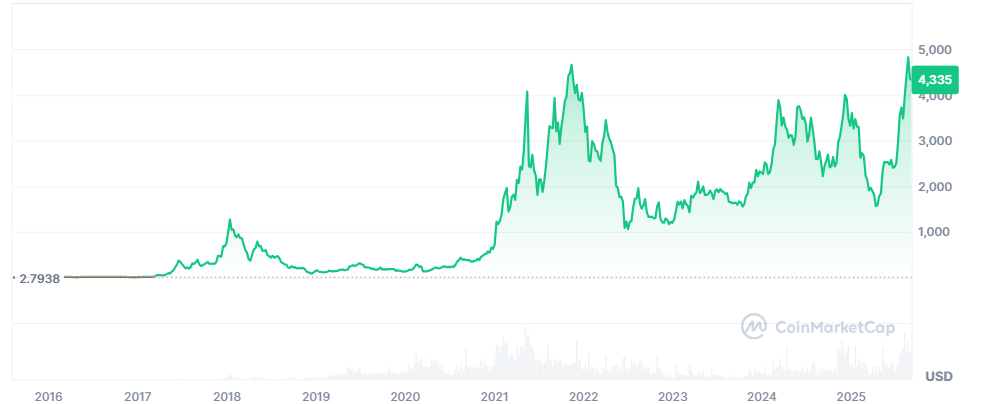Ethereum has been one of the most influential forces in the cryptocurrency market since its launch in 2015. Unlike Bitcoin, which primarily functions as a digital currency and store of value, Ethereum was designed as a decentralized platform to support smart contracts and decentralized applications (dApps). This fundamental difference has allowed Ethereum to dominate sectors such as Decentralized Finance (DeFi), Non-Fungible Tokens (NFTs), and more recently, Layer-2 scaling ecosystems.
As we move into 2025, investors and institutions alike are keenly watching Ethereum. Its transition from Proof of Work (PoW) to Proof of Stake (PoS) in 2022 through The Merge has completely reshaped the supply dynamics of ETH. Combined with growing institutional interest, a booming staking economy, and new scalability solutions, Ethereum is positioned for significant growth.
The big question remains: What could Ethereum’s price look like by 2025?
To answer this, we must explore Ethereum’s history, current market structure, technological advancements, potential catalysts, risks, and the predictions made by leading experts.
A Brief History of Ethereum’s Price Performance
Ethereum’s price journey has been nothing short of dramatic. Launched in 2015 at under $1, ETH quickly attracted attention due to its ability to host decentralized applications. Its first major bull run came in 2017, when Ethereum surged from under $10 to nearly $1,400, fueled by the ICO boom.
The subsequent bear market saw ETH crash to below $100 in late 2018, reflecting the volatility and speculative cycles common in crypto. However, the rise of DeFi in 2020 and NFTs in 2021 brought Ethereum back into the spotlight. ETH reached an all-time high of around $4,878 in November 2021, marking its peak during the last bull cycle.
The bear market of 2022–2023 saw Ethereum’s price decline significantly, dropping under $1,000 at one point. Yet, Ethereum’s fundamentals remained strong, especially as The Merge in September 2022 reduced new ETH issuance by over 90%. This upgrade, combined with burning mechanisms introduced in EIP-1559 (2021), has made ETH increasingly scarce.
By mid-2025, ETH trades around the $5,000 range, and investors are looking ahead to whether Ethereum can break new highs by the end of the year.
Key Factors Influencing Ethereum’s Price in 2025
1. The Impact of The Merge and Proof of Stake
Ethereum’s shift to Proof of Stake was one of the most important changes in its history. Under PoS, new ETH is no longer mined but staked by validators. This has:
-
Reduced ETH issuance by more than 90% compared to the old PoW model.
-
Introduced a deflationary element when network activity is high (since transaction fees are burned via EIP-1559).
This dual mechanism of reduced issuance and burning supply makes ETH behave more like “ultra-sound money,” a term often used in the Ethereum community. If adoption and transaction activity increase through 2025, ETH supply could decrease further, pushing prices higher.
2. Ethereum Staking and Yield Generation
One of the biggest attractions for Ethereum investors in 2025 is staking rewards. By locking ETH to secure the network, stakers earn passive income. With millions of ETH now staked, Ethereum has transformed into a yield-bearing digital asset, making it more appealing to both retail and institutional investors.
Unlike Bitcoin, which provides no yield, Ethereum offers a combination of capital appreciation and passive returns. This makes ETH competitive not only with Bitcoin but also with traditional yield-generating assets like bonds. In a high-interest-rate environment, staking rewards provide additional motivation for long-term holding.
3. DeFi and NFTs – Ethereum’s Ecosystem Advantage
Ethereum continues to dominate DeFi with protocols like Uniswap, Aave, and MakerDAO, which collectively secure billions of dollars in total value locked (TVL). NFTs, though quieter compared to 2021’s hype, are still primarily built on Ethereum standards such as ERC-721 and ERC-1155.
The growth of Web3 gaming, tokenization of real-world assets, and decentralized identity solutions are all powered by Ethereum. This ensures a steady demand for ETH, as gas fees remain essential to using the network.
4. Layer-2 Scaling Solutions
One of Ethereum’s main challenges has been scalability. High fees during peak usage have often pushed users toward alternative blockchains like Solana or Binance Smart Chain.
By 2025, Ethereum’s Layer-2 rollups — such as Arbitrum, Optimism, zkSync, and StarkNet — have significantly reduced transaction costs and increased throughput. These solutions allow Ethereum to compete effectively with high-speed chains, while still maintaining the security of the Ethereum base layer.
The success of these Layer-2 ecosystems directly correlates with Ethereum’s long-term price appreciation, as they bring in more users and developers without straining the mainnet.
5. Institutional Adoption and ETH ETFs
Institutional adoption is one of the strongest bullish catalysts for Ethereum in 2025. Following Bitcoin ETFs in 2024, the U.S. and European markets are increasingly considering Ethereum Spot ETFs. If approved, they could bring billions in inflows from pension funds, asset managers, and family offices.
Additionally, Ethereum’s staking yield makes it particularly attractive to institutions seeking both growth and income. With the traditional financial system struggling under inflationary pressures and rising government debt, ETH is increasingly viewed as a hedge and alternative investment class.
6. Competition from Other Smart Contract Platforms
While Ethereum remains dominant, it faces strong competition from platforms like Solana, Cardano, Avalanche, and Polkadot. These networks often advertise lower fees and faster transactions.
However, Ethereum’s first-mover advantage, massive developer community, and ecosystem lock-in make it difficult for rivals to truly replace ETH. Instead, the market is more likely to evolve as a multi-chain world where Ethereum acts as the primary settlement layer.
7. Regulatory Landscape
Global regulation remains a double-edged sword for Ethereum. On one hand, clarity around securities laws and taxation could encourage more institutional adoption. On the other hand, strict rules around staking or DeFi could limit Ethereum’s growth.
By 2025, the U.S. SEC has softened its stance on Ethereum, increasingly treating ETH as a commodity rather than a security. This regulatory clarity has boosted investor confidence, although DeFi protocols still face ongoing scrutiny.
8. Macro-Economic Factors
Ethereum’s price cannot be separated from global economic conditions. Inflation, interest rates, dollar strength, and geopolitical instability all play roles in shaping crypto markets.
If inflation remains high, Ethereum may benefit as a hedge against fiat currency devaluation. If central banks cut rates, more liquidity could flow into risk assets, boosting ETH’s price further. Similarly, the growth of tokenized real-world assets (RWAs) on Ethereum positions it as a key player in bridging traditional finance with blockchain.
Ethereum Price Predictions for 2025
Now let’s analyze Ethereum’s potential price scenarios for 2025 based on bullish, bearish, and realistic outlooks.
Bullish Scenario
In a bullish outcome, Ethereum benefits from widespread institutional adoption, strong DeFi growth, high staking participation, and successful scaling solutions. With ETH supply potentially decreasing due to burning, ETH could surpass its all-time high and reach $8,000 to $10,000 by late 2025.
Bearish Scenario
In a bearish case, Ethereum struggles with regulatory challenges, Layer-2 adoption slows, or competition eats into its market share. Combined with a potential global recession, ETH could remain stuck between $2,000 and $3,500.
Base Case (Most Likely Scenario)
A balanced outlook sees Ethereum steadily growing its ecosystem while attracting institutional inflows. With moderate inflation, continued staking growth, and ETF approval, ETH could realistically trade between $5,500 and $7,000 by the end of 2025.
Comparing Ethereum to Bitcoin in 2025
Ethereum and Bitcoin remain the two pillars of the cryptocurrency market, but their roles differ. Bitcoin acts as digital gold, while Ethereum functions as the world’s decentralized computer.
The ETH/BTC ratio is a useful metric to track investor preference. If Ethereum continues to expand in DeFi, NFTs, and staking, it may gain ground on Bitcoin. However, Bitcoin’s simplicity and recognition keep it as the safer asset for many investors. By 2025, ETH is expected to outperform BTC in percentage gains, though Bitcoin will likely retain the largest market cap.
Risks and Challenges for Ethereum Investors
While Ethereum’s outlook is strong, investors must be mindful of risks:
-
Regulatory Uncertainty: Governments may impose strict rules on DeFi or staking.
-
Technical Risks: Bugs in smart contracts or Layer-2 solutions could trigger market shocks.
-
Competition: Rival chains could erode Ethereum’s dominance.
-
Market Cycles: Crypto remains volatile, and another bear market could push ETH prices lower.
Long-term investors must diversify, manage risk, and stay updated with regulatory and technological developments.
Investment Strategies for 2025
For investors looking at Ethereum in 2025, several strategies stand out:
-
Long-Term Holding (HODL): Treat ETH as a core crypto asset alongside BTC.
-
Staking: Earn passive yield while holding ETH long-term.
-
Diversification: Balance ETH with Bitcoin and select altcoins to manage risk.
-
Dollar-Cost Averaging (DCA): Gradually accumulate ETH to reduce exposure to volatility.
Expert Predictions
Several major institutions and analysts have weighed in on Ethereum’s future:
-
VanEck predicts ETH could reach $11,000 by 2030, driven by DeFi adoption.
-
Standard Chartered Bank expects Ethereum to trade between $8,000–$10,000 by 2025.
-
ARK Invest is even more bullish, suggesting ETH could reach $20,000+ by the end of the decade under favorable conditions.
These forecasts highlight Ethereum’s potential, though they come with inherent risks.
Conclusion
Ethereum remains at the forefront of blockchain innovation in 2025. With its successful transition to Proof of Stake, strong staking economy, dominance in DeFi and NFTs, and growing institutional adoption, Ethereum is well positioned for long-term growth.
While risks such as regulation and competition remain, Ethereum’s fundamentals are stronger than ever. For investors, ETH represents both a high-growth asset and a source of passive yield through staking.
By the end of 2025, Ethereum could trade anywhere between $5,500 and $10,000, depending on how market conditions and adoption trends evolve. For those willing to embrace volatility, Ethereum continues to offer some of the most exciting opportunities in the crypto market.
FAQs
1. Will Ethereum reach $10,000 by 2025?
It is possible under a bullish scenario with ETF approval, institutional adoption, and strong network growth. However, the base case prediction is $5,500–$7,000.
2. Is Ethereum a better investment than Bitcoin?
Ethereum offers staking rewards and more utility, while Bitcoin is more established as a store of value. Both have roles in a balanced portfolio.
3. What are the main risks for Ethereum?
Regulatory changes, competition from other smart contract platforms, and technical issues remain the biggest risks.
4. Can Ethereum become deflationary?
Yes. With staking and EIP-1559 burning mechanisms, ETH’s supply can shrink during high network usage.
5. Should I stake my ETH in 2025?
Staking provides yield and strengthens the network, but investors must weigh liquidity needs and security of staking providers.

